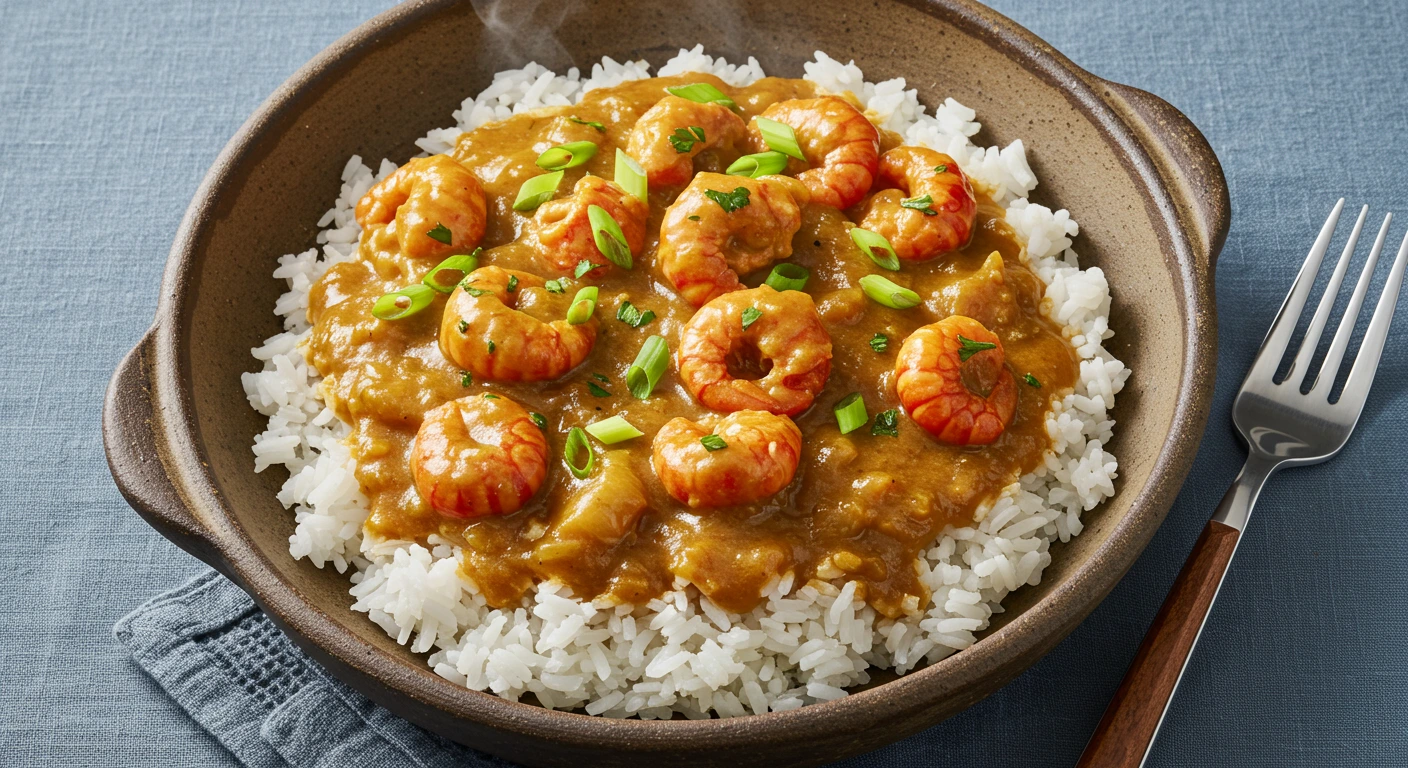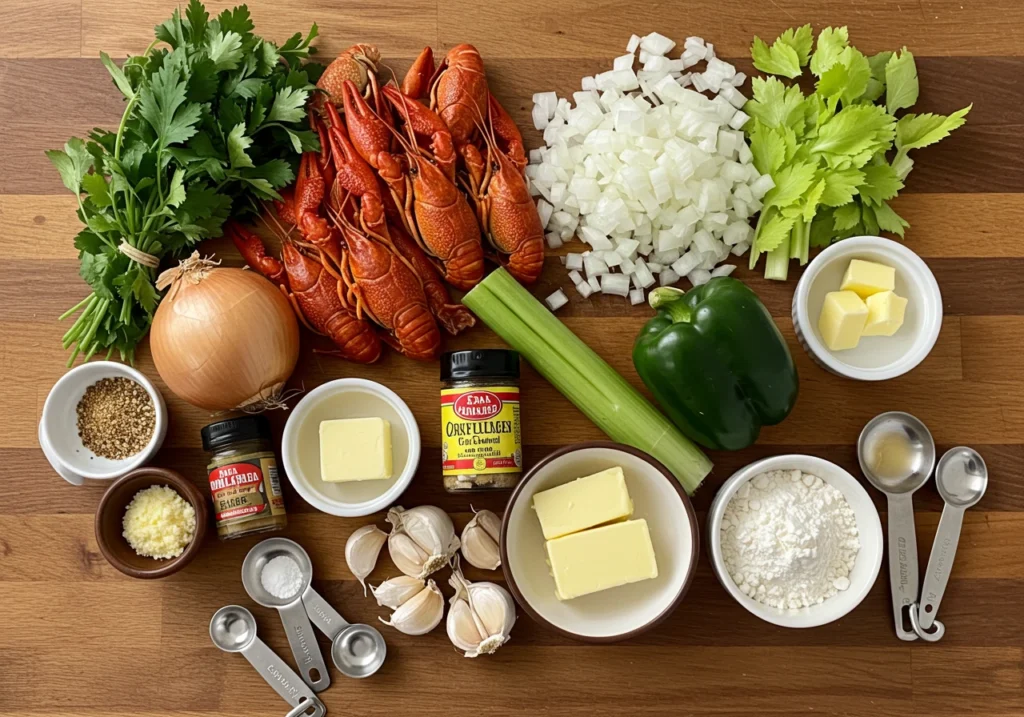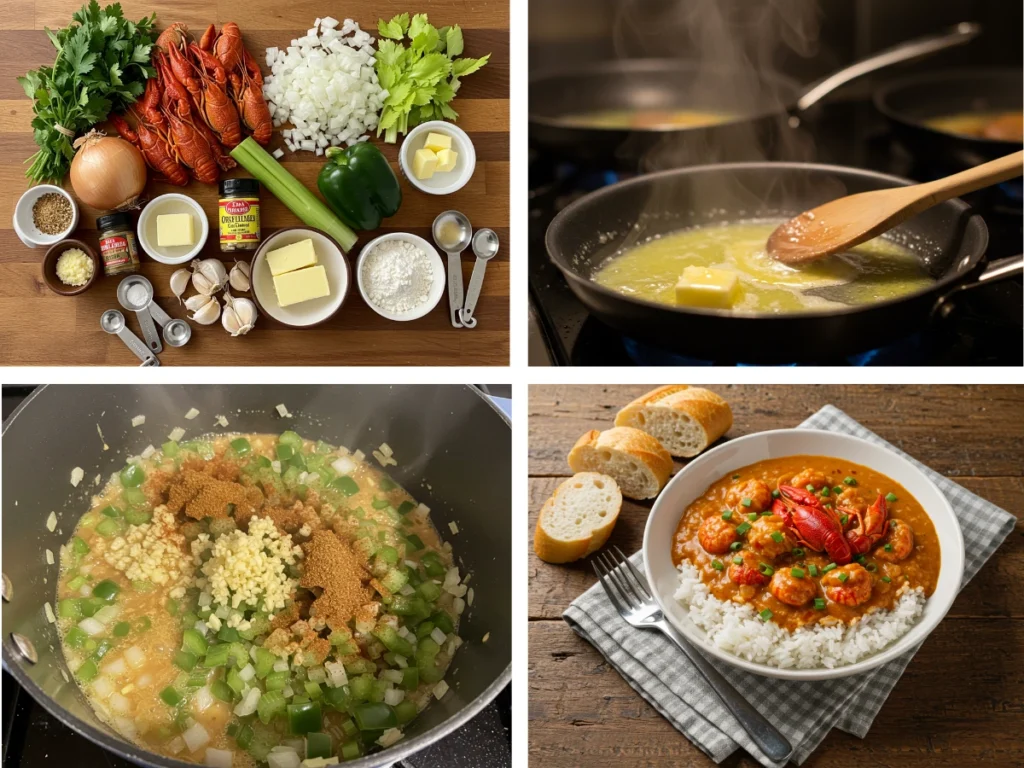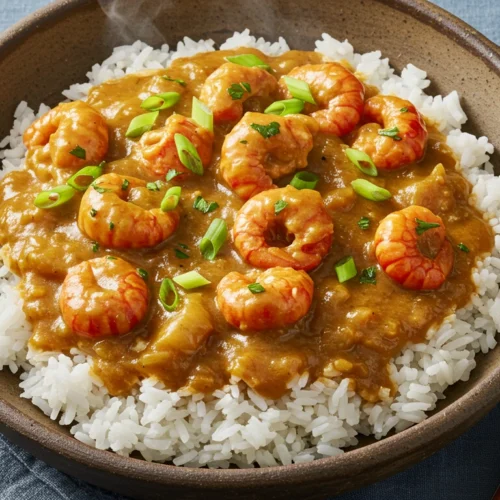Crawfish Etouffee Recipe

If you’ve ever wandered through Louisiana, you know there’s something magical about the food. It’s rich, comforting, layered with flavor, and full of soul. And at the heart of it? Crawfish etouffee. Whether you’re craving the best crawfish etouffee recipe, looking for an authentic crawfish etouffee recipe, or wondering how a creole crawfish etouffee recipe compares to Cajun versions, you’re in the right place.
Let’s dive into everything you need to know to make this Southern classic right in your own kitchen.
Table of Contents
What is Crawfish Etouffee?
Origins of Crawfish Etouffee in Louisiana
So, what exactly is crawfish etouffee? In short, it’s a hearty, savory stew packed with crawfish tails simmered in a deeply flavorful sauce. The word etouffee comes from the French word meaning “smothered,” which is exactly what you do with the crawfish — you smother them in a rich, roux-based sauce.
Etouffee has been a staple in Louisiana kitchens for generations. It traces its roots back to the 1920s, particularly in Breaux Bridge, Louisiana — often called the “Crawfish Capital of the World.” That’s where local home cooks began simmering wild-caught crawfish in a buttery sauce thickened with flour and seasoned with Louisiana’s famous trinity of onion, bell pepper, and celery.
Differences Between Cajun and Creole Crawfish Etouffee
Now, you might be wondering: what’s the difference between Cajun and Creole crawfish etouffee recipes? Here’s the secret — it’s all about the tomato. Creole crawfish etouffee typically includes tomatoes or tomato paste, giving it a slightly redder hue and subtle sweetness. Cajun versions often skip the tomato altogether, focusing on the roux and Cajun seasoning to build flavor.
Both versions are absolutely delicious — it really comes down to personal preference. If you’re after something richer and darker, go Cajun. Want a bit more brightness and tang? The Creole version is for you.
Why Crawfish Etouffee is a Beloved Southern Classic
In Louisiana, food isn’t just fuel — it’s community, tradition, and comfort all rolled into one. Crawfish etouffee is a dish that shows up at family reunions, church potlucks, and neighborhood gatherings. It’s served over fluffy white rice and often paired with a cold drink and warm conversation.
It’s also one of the easiest ways to fall in love with Southern cooking. Crawfish etouffee takes humble ingredients and turns them into something show-stopping — no fancy tools or rare spices required. Just patience, heart, and a willingness to get a little messy in the kitchen.
Ingredients You’ll Need for the Best Crawfish Etouffee Recipe
Before we get into cooking, let’s talk ingredients. For the best crawfish etouffee recipe, you don’t need a pantry full of specialty items. You just need a few fresh ingredients and the willingness to build flavor from the ground up.
Crawfish Tails: Fresh vs Frozen
First, the star of the show: crawfish tails. If you live in the South, you might be able to get your hands on freshly peeled crawfish tails, which are unbeatable in flavor. If you’re elsewhere, look for frozen crawfish tails (often labeled as Louisiana crawfish tails) in the seafood section of your grocery store.
A quick tip — check the package and avoid imported crawfish if you can. Wild-caught Louisiana crawfish have a cleaner, sweeter flavor that makes a big difference in this dish.
The Holy Trinity of Cajun Cooking
Every good crawfish etouffee — Cajun or Creole — starts with the “Holy Trinity” of Louisiana cooking: onion, bell pepper, and celery. Think of them as the Southern cousins of the French mirepoix (which uses carrots instead of bell pepper). This trio provides a savory backbone to the dish.
Use roughly equal parts of each — about 1 cup each is a good start for a standard family-sized recipe. Chop them finely so they melt seamlessly into the sauce.
Spices and Seasonings for Authentic Flavor
Next comes the magic: seasoning. For a classic, authentic crawfish etouffee recipe, you’ll need:
- Cajun seasoning (store-bought or homemade)
- Black pepper
- Paprika
- Cayenne pepper (for heat, if you like it spicy)
- Garlic (fresh minced is best)
Some cooks swear by a splash of Worcestershire sauce or a pinch of thyme to deepen the flavor even more.

Optional Ingredients and Variations
Want to put your own spin on things? Here are a few optional twists:
- Tomatoes: Add them if you’re making a creole crawfish etouffee recipe.
- Stock or broth: Many folks use seafood or chicken stock instead of water to give the dish even more depth.
- Butter vs oil: Butter gives a rich, silky finish. Some cooks use a mix of butter and vegetable oil for their roux.
How to Make an Authentic Crawfish Etouffee Recipe
So, you’ve got your ingredients. Now what? Let’s break down how to make this classic dish step-by-step. This method works whether you want the best crawfish etouffee recipe, a Cajun classic, or a Creole version.
Prepping Your Ingredients
Before you turn on the stove, chop your onions, bell peppers, and celery. Mince the garlic. Measure out your seasoning mix. And thaw your crawfish tails if they’re frozen.
Cooking etouffee is part art, part science — the better prepared you are, the smoother things will go.
Making the Perfect Roux
The roux is the heart of etouffee. In a large heavy pot or Dutch oven, melt butter (or butter and oil) over medium heat. Whisk in all-purpose flour until it forms a smooth paste. Then keep stirring — don’t stop!
You want the roux to turn a beautiful medium-brown color, something like peanut butter. This usually takes 5-10 minutes. Be careful: roux can burn fast, and once it does, there’s no saving it.
Cooking the Etouffee Base
Once your roux is ready, toss in the chopped onion, bell pepper, and celery. Stir constantly until the vegetables soften — about 5 minutes. Add the garlic and cook another minute.
Next, sprinkle in your Cajun seasoning and other spices. Stir well so the flavors bloom in the hot fat. Then slowly whisk in warm stock (seafood or chicken), stirring constantly until smooth.
Bring the mixture to a simmer and let it cook until thickened — about 10-15 minutes. Finally, add your crawfish tails and cook just until they’re heated through, about 5 more minutes. You don’t want to overcook them, or they’ll turn rubbery.

Step-by-Step Crawfish Etouffee Recipe
Here’s a quick recap you can follow in your kitchen — consider this your cheat sheet for a crawfish etouffee recipe that never fails.
Ingredients List
- 1 stick (1/2 cup) butter
- 1/2 cup all-purpose flour
- 1 cup diced onion
- 1 cup diced green bell pepper
- 1 cup diced celery
- 4 cloves garlic, minced
- 2 cups seafood or chicken stock
- 1-2 lbs crawfish tails
- 1 tablespoon Cajun seasoning
- Salt, black pepper, cayenne pepper (to taste)
- Chopped parsley and green onions (for garnish)
- Cooked white rice (for serving)
Detailed Cooking Instructions
- Melt butter in a heavy pot. Stir in flour and cook, stirring constantly, until the roux is medium brown.
- Add onion, bell pepper, and celery. Cook until soft.
- Stir in garlic and cook for 1 minute.
- Add Cajun seasoning and stir.
- Slowly whisk in stock, stirring constantly. Simmer until thickened.
- Stir in crawfish tails and cook 5 minutes.
- Season to taste and serve over rice, garnished with parsley and green onions.
Tips for Thickening and Seasoning
- If your sauce is too thin, let it simmer uncovered a bit longer.
- Taste as you go — adjust salt, pepper, and cayenne to get the heat just right.
- A squeeze of fresh lemon juice at the end brightens everything beautifully.
Creole Crawfish Etouffee Recipe vs Cajun Etouffee
You’ve probably heard folks debate over which version is really the best: Cajun or Creole crawfish etouffee. Here’s the thing — both are incredible in their own way. But what actually sets them apart?
Key Flavor Differences
At the heart of the debate is the tomato. A creole crawfish etouffee recipe usually calls for diced tomatoes or tomato paste. This addition gives the dish a touch of acidity and a beautiful reddish hue. It’s bright, slightly sweet, and has a more layered tang.
On the flip side, Cajun etouffee typically skips the tomato altogether, focusing instead on the deep, nutty flavor of a dark roux and bold Cajun seasonings. It’s earthier, a little spicier, and often a bit richer.
Think of Creole etouffee as the jazz club in New Orleans — bright, energetic, and a bit fancy. Cajun etouffee is like sitting on the porch in the bayou, barefoot with a cold drink in hand — rustic, warm, and unapologetically bold.
Ingredients That Set Them Apart
Beyond tomatoes, you might also notice Creole etouffee recipes include herbs like thyme or bay leaf, and sometimes even a splash of white wine. These ingredients layer in subtle complexity.
Cajun recipes tend to stick closer to the basics: butter, flour, stock, and a heavy hand with the Cajun spice mix. No fuss, just big flavor.
Which Version Should You Try First?
Here’s my take: if you love tomato-based stews and want a touch of acidity to balance the buttery sauce, go Creole. If you want to lean into the rich, smoky flavor of the roux and let the crawfish shine, start with Cajun.
No matter which route you choose, you’re going to end up with something hearty, comforting, and downright delicious.
Serving and Pairing Your Crawfish Etouffee
You’ve cooked up a pot of steaming hot crawfish etouffee — now how do you serve it up right? While there are no hard rules, there are some classic ways folks in Louisiana dish it out that’ll make you feel like you’re sitting at a family table in Lafayette.
Best Rice to Serve With Etouffee
Crawfish etouffee needs rice. Plain, fluffy white rice is the traditional choice — it soaks up that rich gravy and helps balance the spice and savoriness of the dish.
Some folks like long grain rice, others swear by medium grain. The real secret? Don’t overcook it. You want each grain tender but separate so it doesn’t turn into mush under your etouffee.
If you want to try something different, brown rice can add a nutty, earthy note. Or make it fancy with a bit of butter or chicken stock in your rice cooker.
Side Dishes to Complement the Dish
Etouffee is pretty hearty on its own, but a few sides make the meal feel extra special. Here are some ideas:
- French bread or cornbread: Perfect for soaking up extra sauce.
- Simple salad: A crisp green salad with a light vinaigrette cuts through the richness.
- Fried okra: Adds crunch and classic Southern flair.
You don’t have to serve anything else — crawfish etouffee and rice alone are enough to satisfy even the hungriest crowd.
Garnishes for Added Flavor
Once you’ve spooned your etouffee over a bed of rice, top it off with chopped fresh parsley and sliced green onions. A sprinkle of these bright herbs adds color and a pop of freshness that balances out the deep, buttery sauce.
If you like a little acidity, squeeze a bit of fresh lemon juice over the top. It perks everything up and keeps the dish from feeling too heavy.
Tips for Storing and Reheating Leftover Crawfish Etouffee
Crawfish etouffee is one of those dishes that actually tastes better the next day — the flavors meld, the sauce thickens, and the seasoning seeps into every bite. So don’t worry if you’ve got leftovers.
How Long Can You Store Etouffee?
Stored in an airtight container, crawfish etouffee will last about 3 to 4 days in the refrigerator. Just make sure you let it cool before sealing it up so condensation doesn’t water down the sauce.
Freezing Crawfish Etouffee Safely
You can also freeze etouffee if you want to save it longer. Just portion it into freezer-safe containers or heavy-duty freezer bags. It’ll keep well for up to 3 months.
A quick tip: when reheating frozen etouffee, thaw it overnight in the fridge if you can. That way, it heats evenly and doesn’t break or separate.
Best Way to Reheat Without Losing Flavor
To reheat, pour the etouffee into a saucepan over medium-low heat and stir occasionally until hot. If it’s too thick, add a splash of water or stock. Avoid the microwave if you can — it tends to heat unevenly and can make the crawfish rubbery.
Frequently Asked Questions About Crawfish Etouffee
Let’s tackle some common questions folks often have when making this classic dish.
Can I Substitute Shrimp or Other Seafood?
Absolutely. If crawfish tails are hard to find, shrimp makes a fantastic substitute. Just peel and devein them first, and cook them in the sauce until they’re pink and firm — usually about 3-4 minutes.
Some cooks also toss in crab meat or even chunks of white fish to bulk out the dish. It’s not traditional, but it sure is tasty.
How Spicy Should Crawfish Etouffee Be?
That’s completely up to you. Traditionally, etouffee has a gentle warmth rather than fiery heat. But if you like things on the spicier side, don’t hold back on the cayenne or toss in a few dashes of hot sauce at the end.
Taste as you go, and remember — you can always add more spice, but you can’t take it out.
Where Can I Find Crawfish Tails?
If you’re not lucky enough to live near a fresh seafood market in the South, check the frozen section of your grocery store. Look for packages labeled Louisiana crawfish tails — they’re usually pre-cooked and ready to go.
If all else fails, specialty online retailers often ship them nationwide.
Why You Should Try This Crawfish Etouffee Recipe Today
Here’s the bottom line: crawfish etouffee is more than just a recipe — it’s a little taste of Southern tradition that brings people together around the table. Whether you’re making the best crawfish etouffee recipe to impress guests, whipping up an authentic crawfish etouffee recipe for family, or experimenting with a creole crawfish etouffee recipe to try something new, you really can’t go wrong.
It’s the kind of dish that warms you from the inside out — a big, buttery hug in a bowl. So roll up your sleeves, grab your ingredients, and get cooking. Your kitchen is about to smell like heaven.
More Seafood Recipes You’ll Love

Crawfish Etouffee Recipe
Ingredients
- 1 stick 1/2 cup butter
- 1/2 cup all-purpose flour
- 1 cup diced onion
- 1 cup diced green bell pepper
- 1 cup diced celery
- 4 cloves garlic minced
- 2 cups seafood or chicken stock
- 1-2 lbs crawfish tails fresh or thawed from frozen
- 1 tablespoon Cajun seasoning
- 1/2 teaspoon black pepper
- 1/4 teaspoon cayenne pepper optional, adjust to taste
- Salt to taste
- 1/4 cup chopped parsley for garnish
- 1/4 cup sliced green onions for garnish
- Cooked white rice for serving
Instructions
- Melt butter in a large heavy pot over medium heat. Stir in flour and cook, stirring constantly, until the roux reaches a medium brown color (similar to peanut butter), about 5-10 minutes.
- Add diced onion, bell pepper, and celery. Stir and cook until softened, about 5 minutes.
- Stir in minced garlic and cook for 1 more minute.
- Add Cajun seasoning, black pepper, and cayenne. Stir to coat the vegetables.
- Slowly whisk in warm seafood or chicken stock, stirring constantly to prevent lumps.
- Bring mixture to a simmer and cook for about 10-15 minutes until thickened.
- Stir in crawfish tails and cook for 5 minutes, just until heated through. Taste and adjust seasoning with salt if needed.
- Serve hot over cooked white rice, topped with chopped parsley and sliced green onions.
Notes
- For a Creole twist, add 1/2 cup diced tomatoes or 2 tablespoons tomato paste with the vegetables.
- Use shrimp instead of crawfish if desired — just cook until pink and firm.
- Adjust spice level by increasing or decreasing cayenne pepper.
Review Our Recipe: Your Feedback Makes a Difference
There are no reviews yet. Be the first one to write one.
